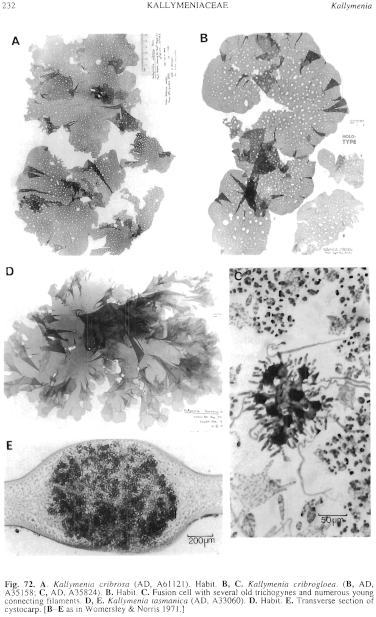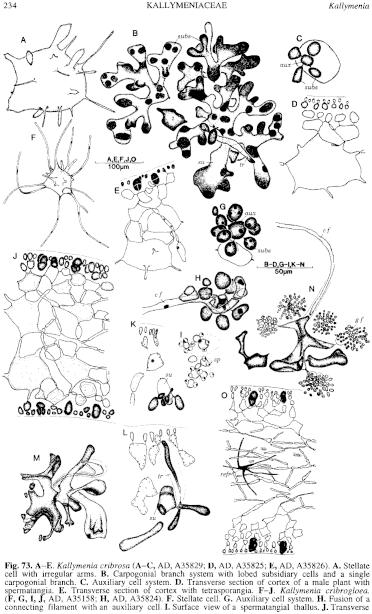|
|
|
|
|
|||||||||||
|
Electronic Flora of South Australia Species Fact Sheet
Phylum Rhodophyta – Class Florideophyceae – Order Gigartinales – Family Kallymeniaceae
Selected citations: Millar & Kraft 1993: 21. Womersley 1973: 253.
Thallus (Fig. 72B) rose-red to red-brown or yellowish-brown, foliose, expanded laterally from a short stipe, undivided or somewhat lobed above, 10–50 cm high and across, with small perforations near the margin and large and small ones irregularly scattered over most of the thallus; larger perforations to 1 (–2) cm in diameter, smaller usually 1–2 mm in diameter; substance gelatinous, firm when fresh. Holdfast discoid, 1–3 mm across; epilithic or on shells. Structure. Thallus (Fig. 73J) mostly 250–700 µm thick, consisting of 2–4 layers
Reproduction: Sexual thalli dioecious. Carpogonial branch systems polycarpogonial with 8–16 carpogonial branches, the first cells of which (and the supporting cell) are spherical to ovoid. Fusion cell (Fig. 72C) lobed, 100–180 µm across, producing numerous connecting filaments. Auxiliary cell systems (Fig. 73G) 40–50 µm across with about 8 subsidiary cells on the supporting cell, some subsidiary cells occasionally producing a daughter cell; following fusion of the auxiliary cell with a connecting filament (Fig. 73H) the adjacent parts of the connecting filament produce numerous gonimoblast filaments which cut off carposporangia. Cystocarps scattered over the thallus, convex to hemispherical, 0.5–1 mm across in surface view, circular to somewhat irregular in outline, lying within the swollen medulla and consisting of a dense mass of filaments and subspherical carposporangia 14–30 µm in diameter. Male thalli with spermatangia covering the surface (Fig. 73I), about 2 µm in diameter, cut off from the outer cortical cells.
Tetrasporangia scattered in the outer cortex (Fig. 73J), cruciately divided, ovoid, 22–36 µm long and 17–25 µm in diameter.
Type from Great Taylor Bay, Bruny I., Tas., 10–16 m deep (Shepherd, 7.ii.1970); holotype in AD, A35158. Isotypes distributed in "Marine Algae of southern Australia" No. 82.
Selected specimens: Waldegrave I., S. Aust., 22 m deep (Shepherd, 17.iv.1970; AD, A35824, A35827). Pearson I., S. Aust., 30 m deep (Shepherd, 10.i.1969; AD, A34044). West Point, Eyre Pen., S. Aust., 15–25 m deep (Shepherd, 25.x.1969; AD, A34764). Troubridge I., S. Aust., 23 m deep (Shepherd, 4.ii.1969; AD, A33803). Muston, Kangaroo I., S. Aust., 5–7 m deep (Owen, 7.iii.1971; AD, A38171). Port Phillip Heads, Vic. (Wilson, 15.i.1883; MEL, 1005775). Jervis Bay, N.S.W., 18 m deep (Shepherd, 15.viii.1972; AD, A 42614).
Distribution: Waldegrave I., S. Aust., to Jervis Bay, N.S.W., and SE Tasmania.
Taxonomic notes: K. cribrogloea is a deep water species, 7–40 m deep. In contrast, K. cribrosa is often found in shallower water (3 m down) though it does occur to 40 m deep.
K. cribrogloea shows remarkable habit and structural similarity to K. cribrosa, and can only be clearly separated on the structure of the carpogonial branch systems, and the auxiliary cell systems which have more subsidiary cells in K. cribrogloea. However, in well-developed plants of K. cribrogloea, the perforations enlarge fairly rapidly and regularly from very small near the margins to larger a few centimetres within the margin and to large perforations 1–2 cm across in old central parts. In K. cribrosa the perforations generally remain smaller and the regular enlargement for a few centimetres from the margin is not so apparent.
References:
MILLAR, A.J.K. & KRAFT, G.T. (1993). Catalogue of Marine and Freshwater Red Algae (Rhodophyta) of New South Wales, including Lord Howe Island, South-western Pacific. Aust. Syst. Bot. 6, 1–90.
WOMERSLEY, H.B.S. & NORRIS, R.E. (1971). The morphology and taxonomy of Australian Kallymeniaceae (Rhodophyta). Aust. J. Bot. Suppl. 2, pp. 1–62.
WOMERSLEY, H.B.S. (1973). Further studies on Australian Kallymeniaceae (Rhodophyta). Trans. R. Soc. S. Aust. 97, 253–256.
The Marine Benthic Flora of Southern Australia Part IIIA complete list of references.
Publication:
Womersley, H.B.S. (14 January, 1994)
The Marine Benthic Flora of Southern Australia
Rhodophyta. Part IIIA, Bangiophyceae and Florideophyceae (to Gigartinales)
Reproduced with permission from The Marine Benthic Flora of Southern Australia Part IIIA 1994, by H.B.S. Womersley. Australian Biological Resources Study, Canberra. Copyright Commonwealth of Australia.
Illustrations in Womersley Part IIIA, 1994: FIGS 72B, C, 73 F–J.

Figure 72 enlarge
Fig. 72. A. Kallymenia cribrosa (AD, A61121). Habit. B, C. Kallymenia cribrogloea. (B, AD, A35158; C, AD, A35824). B. Habit. C. Fusion cell with several old trichogynes and numerous young connecting filaments. D, E. Kallymenia tasmanica (AD, A33060). D. Habit. E. Transverse section of cystocarp. [B–E as in Womersley & Norris 1971.]

Figure 73 enlarge
Fig. 73. A–E. Kallymenia cribrosa (A–C, AD, A35829; D, All, A35825; E, AD, A35826). A. Stellate cell with irregular arms. B. Carpogonial branch system with lobed subsidiary cells and a single carpogonial branch. C. Auxiliary cell system. D. Transverse section of cortex of a male plant with spermatangia. E. Transverse section of cortex with tetrasporangia. F–J. Kallymenia cribrogloea. (F, G, I, J, AD, A35158; H, AD, A35824). F. Stellate cell. G. Auxiliary cell system. H. Fusion of a connecting filament with an auxiliary cell. I. Surface view of a spermatangial thallus. J. Transverse section of a tetrasporangial thallus. K–O. Kallymenia tasmanica (K, L, AD, A33060; M, N, AD, A34362; O, AD, A34270). K. Young carpogonial branch. L. Mature carpogonial branch. M. Fusion cell with old trichogyne and young connecting filaments. N. Auxiliary cell system with fused connecting filament and developing gonimoblasts. O. Transverse section of tetrasporangial thallus. [A-0 after Womersley & Norris 1971.]

|
Email Contact: State Herbarium of South Australia |

|